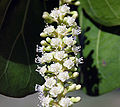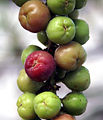- Coccoloba uvifera
-
Coccoloba uvifera 
Scientific classification Kingdom: Plantae (unranked): Angiosperms (unranked): Eudicots (unranked): Core eudicots Order: Caryophyllales Family: Polygonaceae Genus: Coccoloba Species: C. uvifera Binomial name Coccoloba uvifera
L.Coccoloba uvifera is a species of flowering plant in the buckwheat family, Polygonaceae, that is native to coastal beaches throughout tropical America and the Caribbean, including southern Florida, the Bahamas, Barbados and Bermuda. Common names include Seagrape and Baygrape.
Contents
Description
Coccoloba uvifera is a sprawling evergreen shrub or small tree that reaches a maximum height of 8 m (26 ft), but most specimens are little more than 2 m (6.6 ft) tall[citation needed]. It has large, round, leathery leaves (up to 25 cm/9.8 in in diameter) with a primary vein that has a red color extending from the base, and the entire leaf turns red as it ages. The bark is smooth and yellowish.
In late summer it bears green fruit, about 2 cm (0.79 in) diameter, in large grape-like clusters.[1] The fruit gradually ripen to a purplish color. Each contains a large pit that constitutes most of the volume of the fruit.
Cultivation and propagation
Capable of surviving down to approximately 2°C, the tree is unable to survive frost[2]. The leaves turn reddish before falling. Its seeds have to be planted immediately for they can't withstand being stored for future planting unlike most plants.
Coccoloba uvifera is wind resistant [3], moderately tolerant of shade, and highly tolerant of salt, so it is often planted to stabilize beach edges; it is also planted as an ornamental shrub. The fruit is very tasty and can be used for jam or eaten right off the tree.
Coccoloba uvifera is a dioecious species; that is, male and female flowers are borne on separate plants, and cross-pollination is necessary for fruit to develop. Honey bees and other insects help pollinate these plants [4]; male and female plants can be distinguished by the appearance of their flowers, as males usually show dead flower stalks [5].
- Hardiness: USDA zone 9B - 11
- Propagation: seeds and cuttings
- Culture: partial shade/full sun, drought tolerance
Classification
The first botanical names of the plant[2] were assigned in 1696 by Hans Sloane, who called it Prunus maritima racemosa, "maritime grape-cluster Prunus", and Leonard Plukenet, who named it Uvifera littorea, "grape-bearer of the shore", both of which names reflect the European concept of "sea-grape", expressed in a number of languages by the explorers of the times. The natives viewed it as a large mulberry.
The first edition of Linnaeus's Species Plantarum (1753), based on Plukenet, assigned the plant to Polygonum uvifera and noted flores non vidi, "I have not seen the flowers." Subsequently Patrick Browne, The Civil and Natural History of Jamaica (1756) devised Coccoloba, "red-leaf", for it. Relying on Browne, Linnaeus' second edition (1762),[3] changed the classification to Coccolobus uvifera, citing all the other names.
See also
- Bahamian dry forests
- South Florida rocklands
Gallery
References
- Bush, Charles S. and Julia F. Morton. 1969. Native Trees and Plants for Florida Landscaping. Bulletin No. 193, Department of Agriculture - State of Florida.
- Austin, Daniel F. (2004). Florida Ethnobotany. CRC Press. ISBN 0849323320. Preview available, Google Books.
Categories:- Polygonaceae
- Halophytes
- Flora of the Caribbean
- Flora of Florida
- Flora of Bermuda
- Flora of the Bahamas
- Plants described in 1759
- Garden plants of North America
- Fruit
Wikimedia Foundation. 2010.








